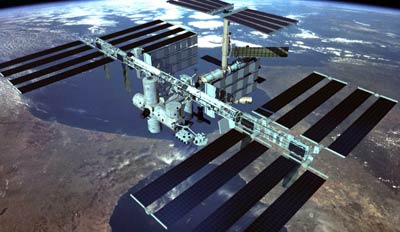 The ISS was built with nearly “minimum-size” modules; a future space station would be better built with a few launches of larger components. (credit: NASA) |
Space station: big or little bricks?
by Marshall D. Martin
Monday, June 27, 2005
While at the Space Access ’05 conference in Phoenix in April, I was confronted by several people that believed “We can build a space station with our rockets.” One proponent stated that New York City was built one brick at a time. Another person pointed out that the Empire State Building was trucked in and erected. I call this the “Little Bricks Theory”. The obvious opposite is the International Space Station being built with the “Big Bricks Theory”
As with most philosophies, each has their strong points and weak points. Listing the features of each would be helpful.
Little bricks failures
- The building of the Empire State Building assumed cheap local labor, with plenty of local food and lodging. There is no labor available in space. There is no lodging in space. There is no food in space.
- There is the option of self-assembly of a space station. This requires each delivered brick to have its own guidance system, its own assembly procedure, its own self-test procedure, and communications system to both the station being built and Earth. This is construction overhead (mass) that must be applied to each brick. Obviously, the smaller the brick the larger (by percentage of mass) the assembly system becomes. The larger the brick the smaller by mass the assembly system becomes.
- Another option is a space robot assembling the space station. This requires a construction robot to collect each brick and assemble the station. This robot would have to be as dexterousness as a human and about the same size. Currently, assembly robots are fixed-place machines working on fixed-place object. Robotic hands are almost capable of moving like human hands, but it may be 50 to 100 years before a robot has the simple sense of touch that the average human experiences in daily life. Robots will not be an option until they can find and fix a space station air leak like the one on ISS Expedition 8 resolved by Michael Foale and Alexander Kaleri.
- There is overhead on the ground. If building the station takes hundreds of small launches a year then there has to be four to ten launch pads. This adds a lot of expense to the small rocket solution. The optimal number of launch pads would be only two: a primary and backup. There are only two space shuttle launching pads.
Space Shuttle brick problems
The International Space Station has major problems of simple supplies. A small problem with the space shuttle delays supplies for weeks. A major space shuttle problem and everything is delayed for years. Obviously, the ISS-size bricks do work but delivery system failures cause big cost overruns. Further, living on ISS is like living in a small railroad boxcar. Living space is very small.
Taking the opposite view, ISS exists. It has been maintained, upgraded, and repaired. It has proven that man can function in space and is required to keep ISS functioning. The Russian Soyuz (small brick) has kept the station going.
A bigger brick solution
| A small problem with the space shuttle delays supplies for weeks. A major space shuttle problem and everything is delayed for years. |
A maximum possible launch vehicle could deliver a nearly complete ISS-size station in only one or two launches. Almost all systems would have been fully tested on the ground before launch. There would be a minimum of interface connections between each section. Therefore, a really large station could be built with five launches and a single space shuttle mission. The astronauts assemble the station while living in the Shuttle for a few days. After the first module is ready for habitation, the astronauts can move-in and work from inside the station.
Like the current ISS, robotic arms and other robotic system will make the construction safer and easier. Better tools and instruments would simplify construction and checkout. But in the final analysis, humans need to be there to detect and fix unforeseen problems.
Amortizing the R&D for a “maximum” launch vehicle (an estimated four billion dollars over 40 launches) and assuming each launch costs 500 million dollars means that a trivial three billion dollars could provide us with a space station four to five times as large as ISS. If properly designed, it could have artificial gravity and better radiation protection. It would be a real stepping-stone into space.
The small brick success
Small launch systems are flexible. They would deliver station supplies and small parts when needed. Supply missions are a major long-term cost of any space station, and a particular weakness of ISS. If a station was expected to last 30 years then the cost of supplies might be significantly larger than the cost of building the space station.
Conclusion
The space shuttle produced a space station with nearly minimum-size modules. It would be difficult and definitely unpleasant to live in a space station built out of Apollo modules. Skylab was a very solid idea and design but, as a single unit, it could not expand. The next space station design must be expandable. The next space station has to have room for long-term living (years not months). The next space station has to have a productive moneymaking task, such as fixing satellites and deorbiting junk. It is time for engineers to be designing the next station. It is time the American voters and taxpayers determine the kind of space station we deserve for our space-directed tax dollars.
Marshall D. Martin (m_martin8@yahoo.com) is a 25-year veteran of the software engineering industry and holds an MBA in Management of Information Systems from Oklahoma City University. He has long had an interest in the aerospace field.
|
